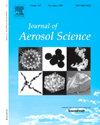软雾吸入器(SMI)装置的雾化特性:雾化颗粒通过呼吸道输送-一项创新的数值和实验研究
IF 3.9
3区 环境科学与生态学
Q2 ENGINEERING, CHEMICAL
引用次数: 0
摘要
软雾吸入器(SMIs)以其创新的设计和高效率而脱颖而出,使其成为吸入治疗高级研究的有希望的候选人。本研究提出了实验和数值方法来区分多相流场在设备口和现实的VCU(弗吉尼亚联邦大学)中型口-喉(MT)气道。采用数值方法,将流体体积法(VOF)与离散相模型(DPM)相结合,结合自适应网格细化技术,对SMI两喷嘴的液体射流破碎机理进行了深入分析。此外,我们还引入了一种新的粒子数据传输方法(PDTM)来跟踪现实MT气道中的雾化粒子。为了验证VOF-DPM模型产生的羽流,采用了高速摄像机和图像分析技术。下一代冲击器(NGI)的实验结果进一步证实了数值模型在模拟气道颗粒沉积方面的准确性。将提出的VOF-DPM-PDTM模型与传统的dpm -随机碰撞模型的结果进行了比较。我们的研究结果表明,将VOF-DPM模型与新型PDTM相结合,可将SMI口腔内药物沉积的预测提高90%。根据VOF-DPM模型,大约28%的药物沉积在口腔区域,这与30%的实验结果非常吻合。分析表明,65%的颗粒发生袋状和多模破碎,质量中值直径约为4.9 μm,在细颗粒和粗颗粒范围内均存在明显的二次峰。图像分析进一步表明,药物气溶胶以约36.5°的角度分散,以25.53 m/s的速度从SMI喷嘴出口移动约0.80 mm。这增加了器械口内的药物损失。我们还为DPM框架引入了一个更精细的颗粒注入数据模型,与现有的预定义版本相比,提供了更多的细节和更高的准确性。本文章由计算机程序翻译,如有差异,请以英文原文为准。

Atomization characteristics of soft mist inhaler (SMI) devices: aerosolized particle delivery through the respiratory tract—an innovative numerical and experimental study
Soft mist inhalers (SMIs) stand out for their innovative design and high efficiency, making them promising candidates for advanced research in inhalation therapy. This study presents both experimental and numerical methods to differentiate multiphase flow fields within the device mouthpiece and the realistic VCU (Virginia Commonwealth University) medium-sized mouth-throat (MT) airway.
Using a numerical approach, the volume of fluid (VOF) method was coupled with the discrete phase model (DPM), incorporating an adaptive mesh refinement technique to thoroughly analyze the liquid jet breakup mechanisms for SMI's two nozzles. Furthermore, we introduced a novel particle data transmission method (PDTM) to track atomized particles in the realistic MT airway. To validate the plume generated by the VOF-DPM model, a high-speed camera along with image analysis techniques were employed. Experimental results from a next-generation impactor (NGI) further confirmed the accuracy of the numerical model in simulating airway particle deposition.
We compared our results from the proposed VOF-DPM-PDTM model to the traditional DPM-stochastic collision model. Our findings indicate that integrating the VOF-DPM model with the novel PDTM improved the prediction of drug deposition in the SMI mouthpiece by up to 90 %. According to the VOF-DPM model, approximately 28 % of the drug is deposited in the mouthpiece area, which aligns closely with the experimental outcome of 30 %. Analysis of the particles revealed that about 65 % undergo bag and multimode breakup, resulting in a mass median diameter of approximately 4.9 μm, with distinct secondary peaks in both fine and coarse particle size ranges. Image analysis further showed that drug aerosols disperse at an angle of approximately 36.5° and travel about 0.80 mm from the SMI nozzle exit at a speed of 25.53 m/s. This contributes to increased drug loss within the device's mouthpiece. We also introduced a more refined particle injection data model for the DPM framework, offering greater detail and improved accuracy compared to the existing predefined version.
求助全文
通过发布文献求助,成功后即可免费获取论文全文。
去求助
来源期刊

Journal of Aerosol Science
环境科学-工程:化工
CiteScore
8.80
自引率
8.90%
发文量
127
审稿时长
35 days
期刊介绍:
Founded in 1970, the Journal of Aerosol Science considers itself the prime vehicle for the publication of original work as well as reviews related to fundamental and applied aerosol research, as well as aerosol instrumentation. Its content is directed at scientists working in engineering disciplines, as well as physics, chemistry, and environmental sciences.
The editors welcome submissions of papers describing recent experimental, numerical, and theoretical research related to the following topics:
1. Fundamental Aerosol Science.
2. Applied Aerosol Science.
3. Instrumentation & Measurement Methods.
 求助内容:
求助内容: 应助结果提醒方式:
应助结果提醒方式:


